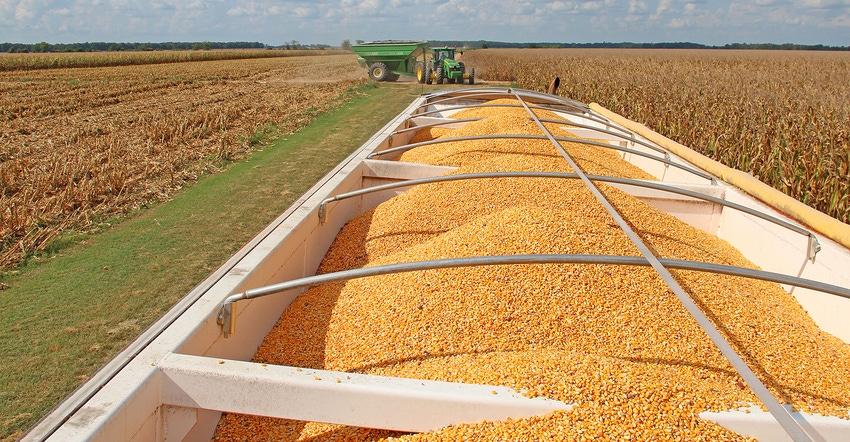
Changes in crop prices—mostly lower except for rice and peanuts—combined with some lower production costs, resulted in relatively minor changes in University of Arkansas Extension crop budgets for 2018.
Breana Watkins, program associate for the University of Arkansas Extension agricultural economics department, says machinery costs and some chemical expenses are down for 2018. “Some chemistry is getting older,” she says, resulting in reduced costs. Some fertilizer costs are also lower.
But market prices for cotton, soybeans, sorghum and corn are down. “We had cotton at 72 cents a pound in last year’s budget,” Watkins says. “It’s at 65 cents this year. Corn is down from $3.75 last year to $3.35 in the 2018 budget. Soybeans at $9.40 are down from $10 last year, and sorghum at $3 is 35 cents lower than in the 2017 budget.
Rice and peanuts are up from a year ago. Rice, at $5.15 is up from $4.25, and peanuts, at $465 a ton moved from $420 last year.
ESTIMATED 2018 RECEIPTS
Anticipated receipt for 2018 cotton is $780 per acre against specified operating costs of $764 per acre for surface irrigation and $825 for pivot irrigation. Corn receipt estimate is $703.50 per acre with specified operating costs for surface irrigation at $648 per acre and $728 under pivots.
Soybean receipts of $564 per acre are balanced against operating costs of $400 for surface and $490 for pivot systems. Peanut receipts, at $1,046 per acre, show operating expenses of $645 for surface irrigation and $686 under pivots.
Sorghum anticipated receipts for 2018 are $315 per acre. Operating expenses for surface irrigation estimate is $370, and $426 for pivots.
Watkins says the 2018 budget offers something of a surprise with conventional rice versus hybrid rice. Yield for conventional rice is estimated at 170 bushels per acre with hybrid production at 190. But receipt estimates show conventional as more profitable. “Even with the yield difference, conventional rice still looks better because of additional labor and other inputs for hybrid rice production,” she says.
Yield estimates for 2018 remain the same as for 2017 and are based on a five-year average from University of Arkansas verifiable research plots. “Arkansas budgets estimate soybean yield at 60 bushels per acre; state average is 50 to 55.”
The budgets estimate cotton at 1,200 pounds per acre, corn at 210 bushels, sorghum at 105 bushels, rice at 170 (conventional) and 190 (hybrid) bushels per acre, and peanuts at 2.25 tons per acre.
“Estimating yield is not an exact science,” Watkins says, “but our numbers are close to state averages. Our numbers may be slightly higher since the state average yields include non-irrigated production,” she explains. “All of our research plots are irrigated.
BUDGET DEVELOPMENT PROCESS
“We get commodity prices and costs for seed and other inputs from USDA.”
In an introduction to the 2018 budget manuscript, contributors explain the process. “Methods employed for developing crop enterprise budgets include input prices that are estimated directly from information available from suppliers and other sources, as well as costs estimated from engineering formulas developed by the American Society of Agricultural and Biological Engineers.
“Input costs for fertilizers and chemicals are estimated by applying prices to typical input rates. Input prices, custom hire rates, and fees are estimated with information from industry contacts. Methods of estimating these operating expenses presented in crop enterprise budgets are identical to producers obtaining costs information for their specific farms.
“Production methods analyzed represent typical field activities as determined by consultations with farmers, county agents, and information from Crop Research Verification Program Coordinators in the Department of Crop, Soil, and Environmental Sciences. Actual production practices vary greatly among individual farms due to management preferences and between production years due to climactic conditions.”
Watkins says the budget analyses are created for generalized circumstances, and assume consistent and coordinated application of budget methods for all field crops to develop meaningful costs and returns comparisons.
She says farmers should use these budgets as aids to decision making for acreage allocations among field crops and as guidelines, considering individual production practices, soil types, and other unique circumstances.
“We want farmers to look at their own records, yield histories and operating costs, and plug them in. Every farm is different, and every farmer will have different numbers,” she says.
Arkansas crop budgets can be found at the University of Arkansas Extension Service website at http://bit.ly/2z8p8fj or contact Watkins at [email protected] or 870.933.4565.
About the Author(s)
You May Also Like






